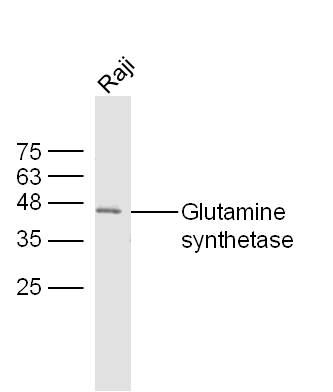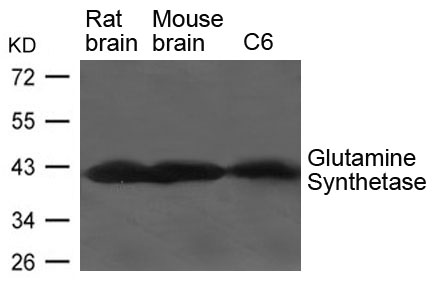Glutamine synthetase antibody
GTX109121
ApplicationsImmunoFluorescence, ImmunoPrecipitation, Western Blot, ImmunoCytoChemistry, ImmunoHistoChemistry, ImmunoHistoChemistry Frozen, ImmunoHistoChemistry Paraffin
Product group Antibodies
ReactivityHuman, Mouse, Rat, Zebra Fish
TargetGLUL
Overview
- SupplierGeneTex
- Product NameGlutamine synthetase antibody
- Delivery Days Customer9
- Application Supplier NoteWB: 1:5000-1:20000. ICC/IF: 1:100-1:1000. IHC-P: 1:100-1:1000. IHC-Fr: 1:100-1:1000. IP: 1:100-1:500. *Optimal dilutions/concentrations should be determined by the researcher.Not tested in other applications.
- ApplicationsImmunoFluorescence, ImmunoPrecipitation, Western Blot, ImmunoCytoChemistry, ImmunoHistoChemistry, ImmunoHistoChemistry Frozen, ImmunoHistoChemistry Paraffin
- CertificationResearch Use Only
- ClonalityPolyclonal
- Concentration0.65 mg/ml
- ConjugateUnconjugated
- Gene ID2752
- Target nameGLUL
- Target descriptionglutamate-ammonia ligase
- Target synonymsDEE116, GLNS, GS, PIG43, PIG59, glutamine synthetase, cell proliferation-inducing protein 59, glutamate decarboxylase, glutamine synthase, palmitoyltransferase GLUL, proliferation-inducing protein 43
- HostRabbit
- IsotypeIgG
- Protein IDP15104
- Protein NameGlutamine synthetase
- Scientific DescriptionGlutamine is a main source of energy and is involved in cell proliferation, inhibition of apoptosis, and cell signaling (Haberle et al., 2005 [PubMed 16267323]). Fetal glutamine requirements are very high and depend largely on active glutamine synthesis and the release of glutamine into the fetal circulation by the placenta. Glutamine synthetase (EC 6.3.1.2), also called glutamate-ammonia ligase (GLUL), is expressed throughout the body and plays an important role in controlling body pH and in removing ammonia from the circulation. The enzyme clears L-glutamate, the major neurotransmitter in the central nervous system, from neuronal synapses (see references in Clancy et al., 1996 [PubMed 8975719]).[supplied by OMIM]
- ReactivityHuman, Mouse, Rat, Zebra Fish
- Storage Instruction-20°C or -80°C,2°C to 8°C
- UNSPSC12352203
References
- Tabor SJ, Yuda K, Deck J, et al. Retinal Injury Activates Complement Expression in Müller Cells Leading to Neuroinflammation and Photoreceptor Cell Death. Cells. 2023,12(13). doi: 10.3390/cells12131754Read this paper
- Xuan DTM, Wu CC, Wang WJ, et al. Glutamine synthetase regulates the immune microenvironment and cancer development through the inflammatory pathway. Int J Med Sci. 2023,20(1):35-49. doi: 10.7150/ijms.75625Read this paper
- Iovino L, Giusti V, Pischedda F, et al. Trafficking of the glutamate transporter is impaired in LRRK2-related Parkinson's disease. Acta Neuropathol. 2022,144(1):81-106. doi: 10.1007/s00401-022-02437-0Read this paper
- Gallego-Durán R, Ampuero J, Pastor-Ramírez H, et al. Liver injury in non-alcoholic fatty liver disease is associated with urea cycle enzyme dysregulation. Sci Rep. 2022,12(1):3418. doi: 10.1038/s41598-022-06614-9Read this paper
- Li Q, Cheng Y, Zhang S, et al. TRPV4-induced Müller cell gliosis and TNF-α elevation-mediated retinal ganglion cell apoptosis in glaucomatous rats via JAK2/STAT3/NF-κB pathway. J Neuroinflammation. 2021,18(1):271. doi: 10.1186/s12974-021-02315-8Read this paper
- Serpe C, Monaco L, Relucenti M, et al. Microglia-Derived Small Extracellular Vesicles Reduce Glioma Growth by Modifying Tumor Cell Metabolism and Enhancing Glutamate Clearance through miR-124. Cells. 2021,10(8). doi: 10.3390/cells10082066Read this paper
- Schmidt A, Armento A, Bussolati O, et al. Hepatoblastoma: glutamine depletion hinders cell viability in the embryonal subtype but high GLUL expression is associated with better overall survival. J Cancer Res Clin Oncol. 2021,147(11):3169-3181. doi: 10.1007/s00432-021-03713-4Read this paper
- Wang H, Lu J, Mandel JA, et al. Patient-Derived Mutant Forms of NFE2L2/NRF2 Drive Aggressive Murine Hepatoblastomas. Cell Mol Gastroenterol Hepatol. 2021,12(1):199-228. doi: 10.1016/j.jcmgh.2021.02.004Read this paper
- Yamada T, Ashida Y, Tatebayashi D, et al. Cancer Cachexia Induces Preferential Skeletal Muscle Myosin Loss When Combined With Denervation. Front Physiol. 2020,11:445. doi: 10.3389/fphys.2020.00445Read this paper
- Nakashima K, Iwashita S, Suzuki T, et al. A spatial similarity of stereochemical environments formed by amino acid residues defines a common epitope of two non-homologous proteins. Sci Rep. 2019,9(1):14818. doi: 10.1038/s41598-019-51350-2Read this paper





![ICC/IF analysis of COS7 cells transiently transfected with Glutamine synthetase plasmid using GTX84426 Glutamine synthetase antibody [1F4].](https://www.genetex.com/upload/website/prouct_img/normal/GTX84426/GTX84426_1079_ICCIF_w_23061420_952.webp)